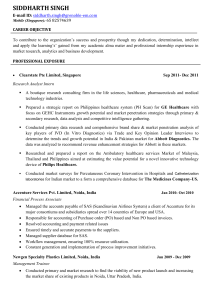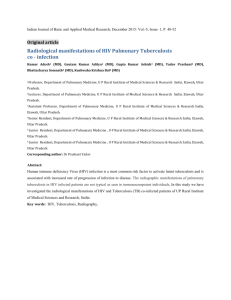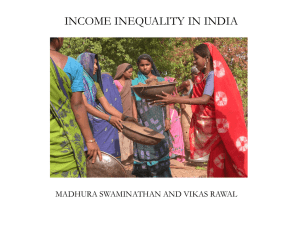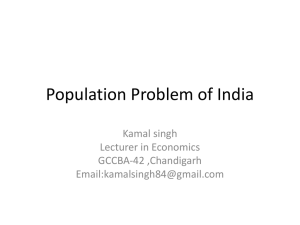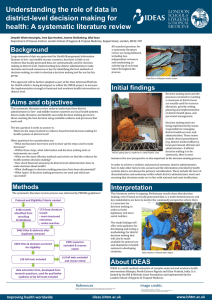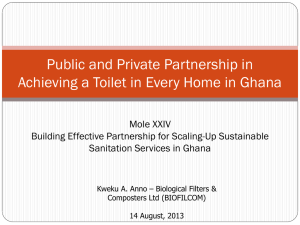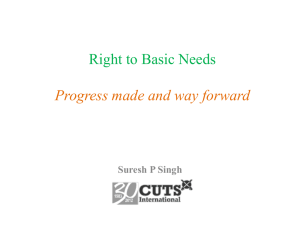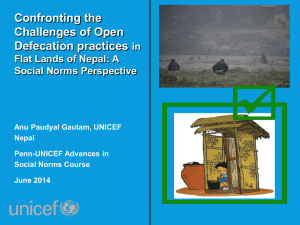Achieving sanitation MDG in Uttar Pradesh: Mr
advertisement
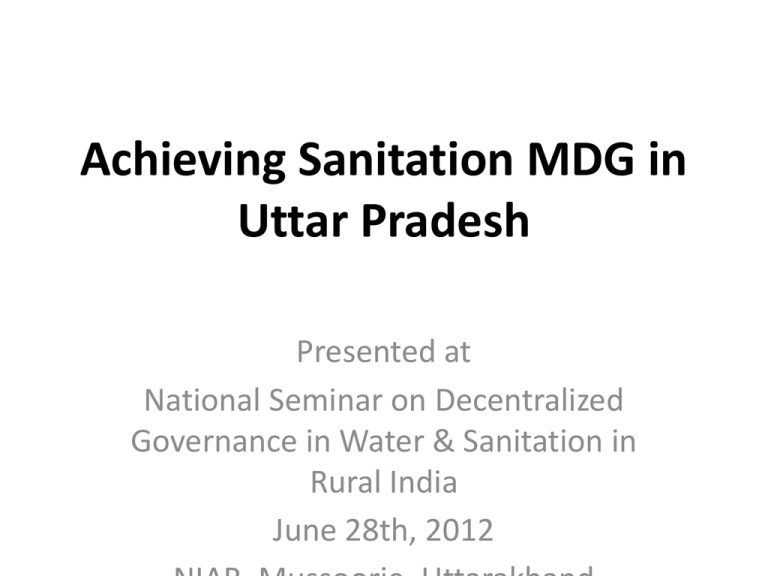
Achieving Sanitation MDG in Uttar Pradesh Presented at National Seminar on Decentralized Governance in Water & Sanitation in Rural India June 28th, 2012 Uttar Pradesh – A Profile • Area 243,290 sq km with population 210 m • Contributes nearly 8% of India’s GDP • Only 5 countries in the world have more population than Uttar Pradesh • One out of every five open defecator in India lives in Uttar Pradesh State Level Disaggregation of Number of Open Defecators Kerala 1 Himachal Pradesh 4 Punjab 11 Haryana 11 27 Gujarat Karnataka 31 Orissa 32 Tamil Nadu 39 West Bengal 39 44 Rajasthan Andhra Pradesh 49 Madhya Pradesh 50 Maharashtra 54 Bihar 71 125 Uttar Pradesh 0 20 40 60 80 100 120 140 Millions Sanitation Trends • Click to edit Master text styles – Second level – Third level • Fourth level – Fifth level Only 6.9% increase in improved sanitation from 1990 to 2006 (16 years) Sanitation Trends in Rural UP • Click to edit Master text styles – Second level – Third level • Fourth level – Fifth level Increased nearly 3 times in last 15 years but grossly inadequate MDG target for Uttar Pradesh • Projected population of UP in 2015 • MDG Target (56.5%) 220 million 124.5 million • MDG achievable at current rate (24%)53 million • Unimproved toilet users 33 millon • Open defecators in 2015 135 million • MDG target shortfall 71.5 million Four Districts Contribute 11% of Open Defecators District Projected Population of Open Defecators (2007) • Allahabad 4,084,668 • Azamgarh 3,741,821 • Jaunpur 3,651,550 • Sitapur 3,429,279 • Click to edit Master text styles – Second level – Third level • Fourth level – Fifth level Open Defecators Second Outline (2007) 18 districts contribute Level 37% of open Ballia Third Outline defecation 2,625,415 Level Name of District Etah 2,574,837 Fourth Outline Projected Level Population of Deoria Fifth Open Defecators 2,561,347 Outline (2007) Budaun Level Gorakhpur 2,561,243 Sixth 3,217,968 Outline Barabanki 2,522,946 Level Hardoi Unnao 3,194,743 • Seventh Outline 2,472,429 LevelClick to edit Sultanpur 3,097,598 Master text styles impacting Toilet Use ave access to toilet facility (%)“ Independent Variables Percent literate Female Population (Age 7+) Model 1 0.85 (0.21)*** Model 2 Model 3 0.48 (0.17)*** Model 4 0.42 (0.16)*** Model 5 0.25 (0.18)* -0.85 (0.11)*** - 0.74 (0.11)*** -0.63 (0.14)*** -0.13 (0.04)*** -0.12 (0.04)*** 0.64 (0.29)** Percent literate male Population (Age 7+) Households have BPL Card (%) Dist cumulative TSC expenditure per capita 0.50 (0.18)*** Households use piped drinking water (%) -22.32 25.30 27.94 29.86 R square 0.19 0.08 0.56 0.61 0.65 Adjusted R square 0.18 0.07 0.54 0.59 70 70 70 Constant -17.68 N 70 ** significant at 1% level; ** significant at 5% level ; * significant at 10% level 70 Remarks 0 20 40 60 80 Access to Sanitation vs Female Literacy 30 40 50 60 Percent literate Female Population (Age 7+) households have access to toilet facility (%) 70 Fitted values one percent increase in female literacy in a district is found associated with 0.25% to 0 20 40 60 80 Access to Toilet Facility vs Water Supply 0 10 20 30 40 households use piped drinking water (%) households have access to toilet facility (%) 50 Fitted values One percent increase in household piped drinking water in a district is associated with 0 20 40 60 80 Access to Toilet Facility vs Poverty 0 20 40 households have BPL Card (%) households have access to toilet facility (%) 60 Fitted values an increase of BPL card holders by 1% in a district results in a decrease of toilet use behavior by Medical Expenses by Income Quintile Income Quintile Lowst Quntile 2nd Lowest Middle 2nd Highest Highest Average Monthly Income Rs 873 Rs 2,186 Rs 3789 Rs 6074 Rs 38,143 medical expenses on diarrhoea, cough, fever Rs 90.98 Rs 192.36 Rs 290.63 Rs 507.92 Rs 1071.51 (10.4%) (8.8%) (7.7%) (8.4%) (2.8%) Net Social Benefits of Total Sanitation • Reduction of deaths of children below 5 years by 90,000 to 100,000 per annum • Averted loss of wages on account of sickness • Averted cost of medicines for treating sickness Net Social Benefits of Total Sanitation in Uttar Pradesh is Rs 10,244 crores (NPV, at 10% discount rate), which is equal to 4% of State Conclusions • Focus on districts with higher concentration of Open Defecators (4 plus 18) • Give priority to those districts which have higher female literacy because of higher chance of success • Give priority to districts with better water supply systems because of higher chance of success • Scope for developing innovative health THANK YOU
